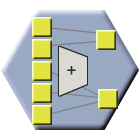Cognitive operator: Reduction by synthesis
Operator
Complexity level
Complexity level of this operator is fractal, between 1 and 2, as this is a reduction of set to a smaller scale, while keeping the global meaning.
Operations
1. Choose inputs that can be worked together for a reduction. 2. Choose one of the inputs as significant synthesis, or propose a new predicate as merged input.
Purpose
Reduction of a large set of input not always can be solved by simple elimination, as some valuable information can exist in less pregnant inputs. The merge operator let eliminate surnumerous inputs, while offerign a way to draw a merged input and keep vlauable information from ideas that will be discarded by the way. This exercice is typical when summmarizing texts or meeting notes and try to keep the essential value of a big mass of information that cannot be handled reasonabiliy.
The operator provides an explicit tool to do this summarizing operation, with adjustable constraints.
Applications
Direct Workflow
- Students brainstorm and add collectively predicates
- Teacher enables and setup a merge operator, with rest to reduce inputs to some definite number
- Students operate separately the merge on their own merging board
- Students observe and analyse other's ideas
- Student report and argue about what can be valuable
- Teacher feedbacks and grades.
This scenario would be likely completed with a collective final Wiki to produce a final version, collectively agreed of the summary.
Reverse Workflow Example
- Teacher setup inputs to be reduced by students
- Teacher enables and setup a merge operator, with rest to reduce inputs to some definite number
- Teacher merges as a teacher answer
- Students operate separately the merge on their own merging board
- Students report about their merge, explaining and justifying
- Teacher analyses work, by displaying pair match or global view
- Teacher feedbacks collectively or individually and grades.
Meta Workflow
This operator can allow teacher to explain the techniques that operate when identifying ideas that could be merged (similarities, redundancy) and can explain how predicates give or not additional informatoin. Teacher can also demonstrate how a merge can be processed as a common cognitive technique to reduce things to essential while having a chance to keep all what is valuable in each original input set.
Implementation
Setup
- number of output: The number of final predicates that must be obtained by reduction.
- allow source reduction: If allowed, students can use the result of one merge to reduce the original source set back.
Teacher options
- blindness: See Cognitive Factory Module for complete information about blindness and privacy behaviour.
Categorize GUI
The main GUI is dedicated to process to source reduction, by assigning some input ideas to a merge group and choose the merge output for the group.
- Blind mode: The user will not have any information about the environment. (forced by Isolated global privacy)
- Semi-blind mode: The GUI adds for each input its preselection statistics from all other peers. The total amount of "new predicates" is also mentionned. Statistics are shown after the participant's merge is done.
- Full view mode: Same as above, but answer statistics are shown also before participant has answered.
Display GUI
- Blind mode:
- If teacher has answered, then a pair comparison to teacher' choise is shown as assessment.
- If teacher has not answered, the result of merge is shown, with statistics upon the environment.
- Semi-blind mode: Same as above, with statistics (number of choices as output, new predicates amount). In addition, an anonymized table of individual results with matching indicators.
- Full view: Same as above, but the global table of results is not anonymized.
Large audience effect :
When the audience becomes too large, the global result tables need to be sliced into pages.
